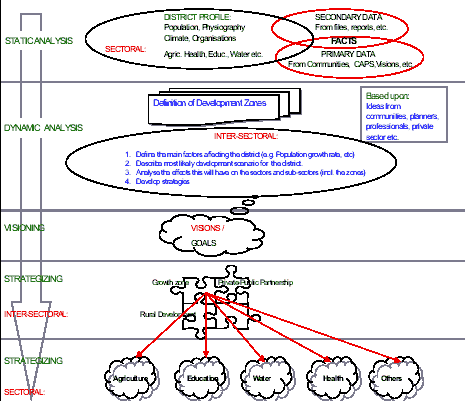District Strategic Planning - Principles and General Procedures
|
|
In order to be able to complete the plan for the district, several main analytical steps have to be completed, these are:
Static analysis: The first part of the process involves undertaking a static analysis. During the static analysis the community and the planning team examine information derived from secondary data (i.e. from existing reports, studies, feasibility reports as well as from the information contained in the community action plans). If secondary data is inadequate (both in terms of quantity and quality) then it may be advisable to collect primary data. However, this is a resource intensive task. Dynamic analysis: During the dynamic analysis stage the information derived from the static analysis is subjected to further inter-sectoral analysis, scenarios and projections. The basic task is to determine how future development options look like, for example if the population continues to grow unchecked, etc. The "optimal" or most likely scenario is selected and further elaborated. Defining spatial zones: While each district in the country is unique, differences within the districts are equally likely. Different parts of the district have quite varied potentials. As a result of the dynamic analysis, the spatial uniqueness of areas can be determined and thus new development zones can be defined. The development zones represent spatial areas with similar unique developmental features (i.e. potentials, resources, etc.). Visioning: For each of the development zones visions have to be formulated. Using the results of the dynamic analysis the creativity of the population and planning group plays an important role in the formulation of the visions. Visions define how all stakeholders perceive the future of the district and they present a long-term view (e.g. 15-25 years) of the development of the district. Visions are bold and "visionary"; they move away from the narrowly viewed medium-term and annual plans (i.e. shopping-lists). Figure 2: From community visions to a district strategic plan
|
|
|
Strategizing: Similarly to the fact that there are different modes of transport (i.e. car, bicycle, aeroplane) that can be employed to reach a specific destination, there are also different strategies that can be used to achieve a vision. Differences in strategies often reflect different philosophies (more growth based or environmentally conscious, etc.). Development strategies should be based upon development theories and concepts. Examples of development theories include: selective closure, export led growth, etc. Apart from the development theories, other more pragmatic aspects also play an important role in the development of strategies including: cost minimization, privatisation, commercialisation, private-public partnerships. National and local laws and policies also guide strategies. Sectoral strategies: Upon completion of the visions and overall development strategy, each sector has to develop a sector strategy. For example, if agreement is reached that private-public partnership strategy should be pursued then the individual sector strategies needs to define what this entails for the agriculture sector, health sector, etc. One consequence could be not to provide free services in those areas that are adequately covered by the private sector and where the communities’ are sufficiently well-off to afford to pay for these services. At the same time the health would redirect their staff to those areas where private services do not exist. |

